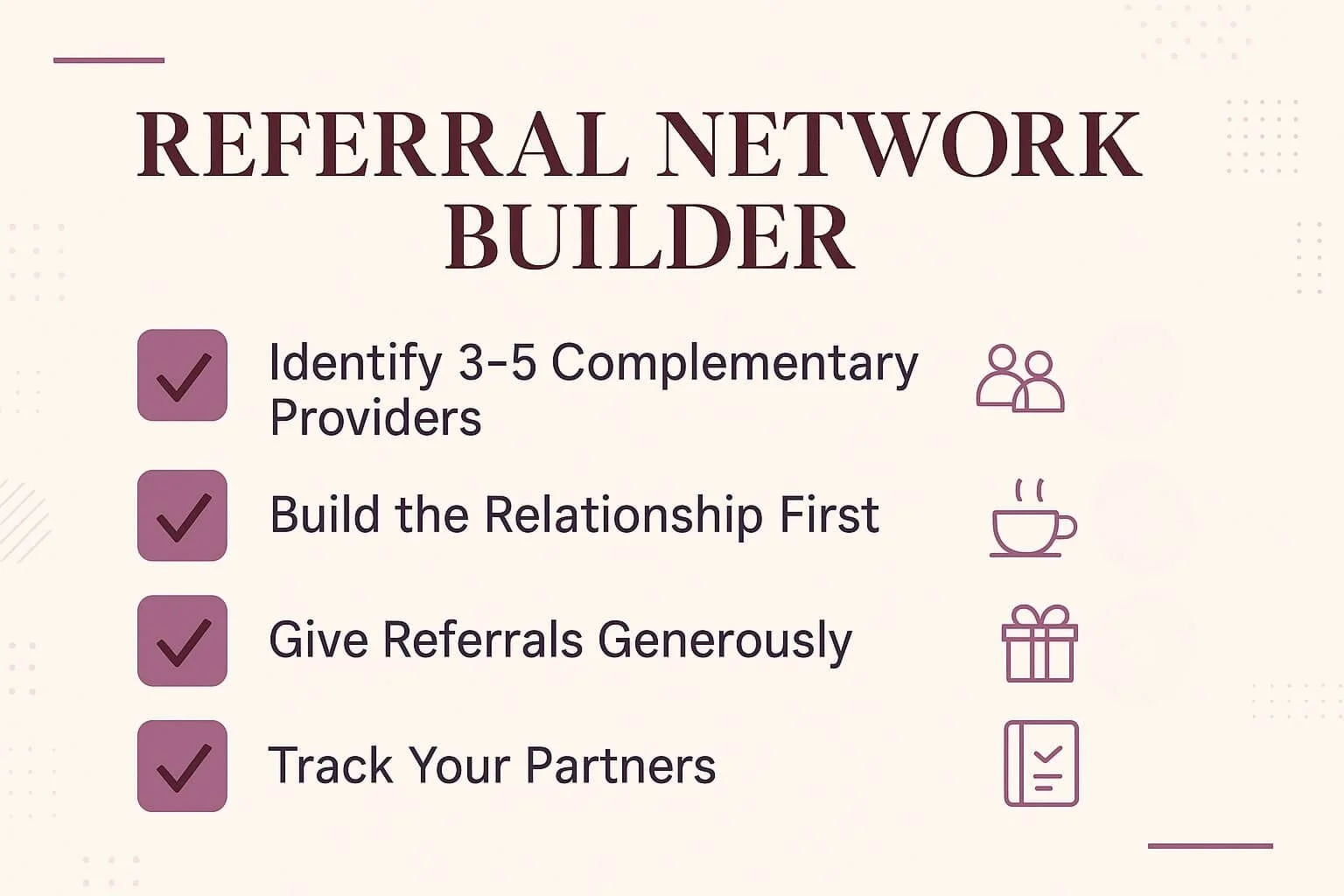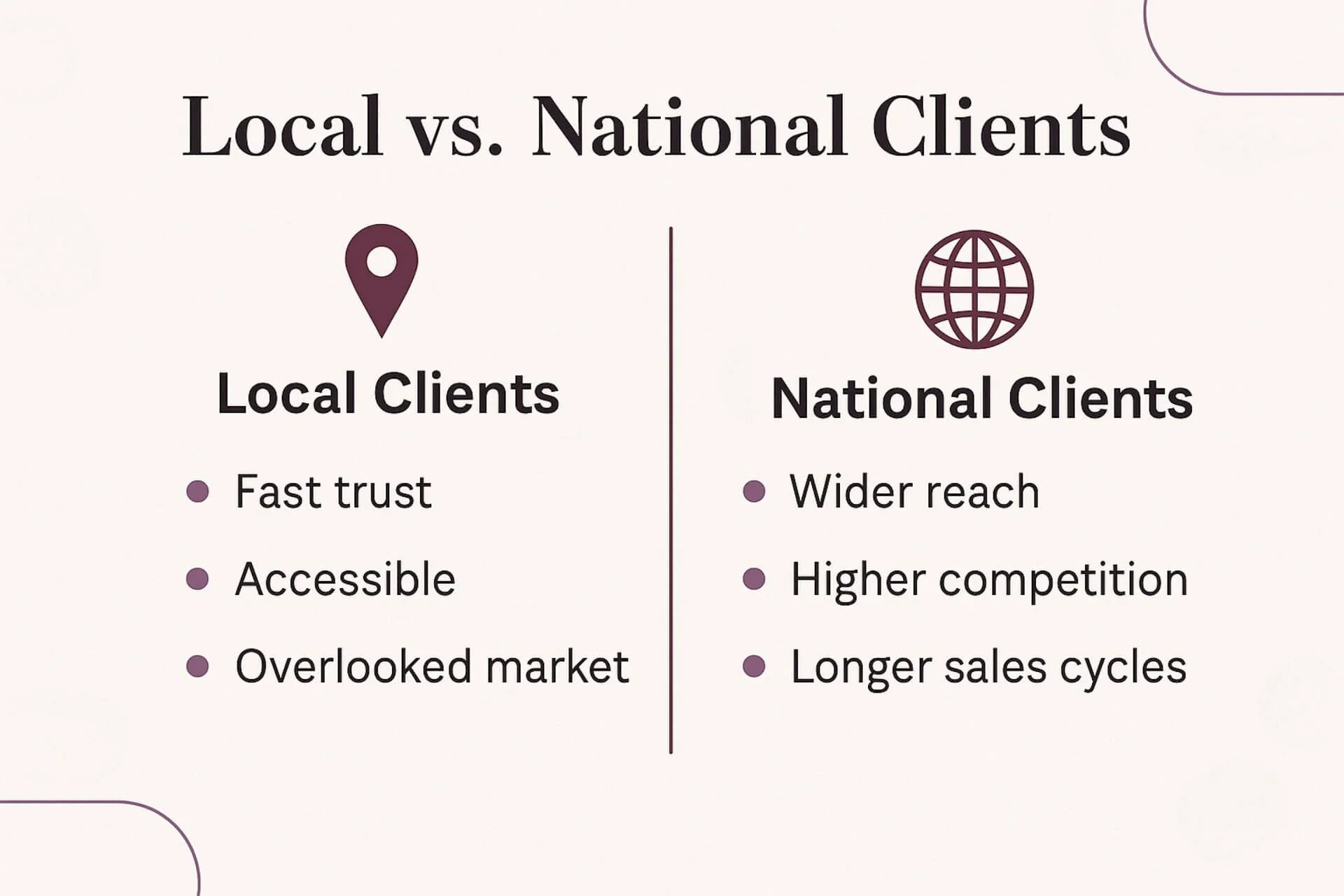How to Get Consulting Clients: 3 Smart Strategies for New Consultants
If you're ready to step into consulting but not sure where the clients are, you're not alone and you're not behind.
One of the most common questions I hear from new consultants is:
“How do I get consulting clients if I don’t have a big audience or fancy website?”
The truth is, landing your first consulting client doesn’t have to be complicated or overwhelming. In fact, my unique approach is rooted in building sustainable growth through real relationships, integrity-first marketing, and practical strategies.
In this guide, I’m sharing 3 smart, proven strategies that have worked for hundreds of my students, and I personally used them to grow my own consulting business.
Prefer to watch instead? Check out my detailed YouTube video here:
Bookmark it if you’re more of a visual learner—you’ll love it.
Strategy #1: Build Your Dream 100 (Even If You Don’t Have a Big Network Yet)
The Dream 100 is your roadmap to finding high-quality consulting clients without chasing everyone and burning out.
Originally coined by Chad Williams (working under Charlie Munger, Warren Buffett’s partner), the concept is simple but powerful: 80% of your business comes from 20% of your clients.
So instead of marketing to everyone, you focus on the 100 ideal clients who are exactly right for you.
I used this myself in my early consulting days and my students rave about how empowering it feels to have a clear, focused list of potential clients.
How to Build Your Dream 100
Make Your List: Your goal is to identify 100 businesses, leaders, or organizations that are aligned with the kind of consulting work you want to do. And no, this doesn’t have to be intimidating.
Start by asking:
Who are the dream clients I’d be excited to work with?
Which industries do I know well or have insider insight into?
Are there gaps in the market I’ve noticed—places where my expertise can add serious value?
Pro tip: Don’t be vague. Get super specific. For example, instead of “online coaches” list: “Scaling online business coaches who generate $500K+ annually but struggle with team and systems.”
The clearer your list, the easier it becomes to target and attract these clients.
Audit Your Current Network: Here’s a truth I love sharing: You’re often closer to your Dream 100 than you realize.
Even if you think, “I don’t have a big network”, I guarantee there are hidden connections waiting to be tapped.
Check LinkedIn connections. Are you already connected to someone on your list?
Look at alumni associations, mastermind groups, or community memberships.
Ask friends and peers if they know anyone in your Dream 100 industries.
Remember: warm intros always outperform cold pitches. Even one degree of separation makes a huge difference in building trust.
Show Up: This is where many people drop the ball. They build a list, but don’t actively engage.
And here’s the thing: The Dream 100 isn’t just about making a list. It’s about building familiarity and trust over time.
Here’s how to show up without being salesy:
Comment thoughtfully on your Dream 100’s LinkedIn posts (skip the generic “Great post!” and actually add value).
Attend live webinars, industry events, or panels where they’re speaking. Introduce yourself in the chat or at the event.
Share their content, tag them when it’s relevant, or send a quick message like:
“I saw your recent interview on [Podcast]. Loved your take on [specific topic], thanks for sharing your insight!”
The goal is relationship-building, not pitching. When your name becomes familiar and trusted, it’s so much easier to open conversations later on.
Want to reach out but unsure how to start? Here’s a sample email you can tweak:
Subject: Quick idea to support [Their Business Name]
Hi [Name],
I’ve been following [Their Business/Organization] and really admire the work you’re doing in [specific detail]. I help businesses like yours [insert your core benefit, e.g., “improve marketing ROI by 30%”], and I’d love to offer a complimentary strategy session to share a few tailored ideas.
No pressure, just valuable insights that you can implement right away.
Would next week work for a 20-minute call?
Best,
[Your Name]
Pro Tip: Make your first ask small: an audit, strategy session, or consultation. This lowers the barrier to entry.
Turning a Dream 100 List into a First Client
One of my students listed local service businesses she loved. She met the owner of a multi-location salon at a local event, shared how she helps businesses grow revenue, and secured her first high-ticket client that same day.
That’s the power of focus.
Want help defining your offer before you start reaching out? That’s exactly what we do inside the Consulting Offer Accelerator. Your Dream 100 is powerful, but only when you’re clear on what you're offering them.
Strategy #2: Create Win-Win Referral Relationships
Let’s talk about something most new consultants overlook: partnerships.
When I was building my business, some of my best clients came not from direct marketing, but from other professionals who served the same audience: fractional CFOs, operations consultants, even copywriters.
Here’s why this works: Referred clients trust you more, convert faster, and stick around longer.
But here's the key: These partnerships work best when they’re truly win-win. That means no spammy DMs or awkward pitches. It’s about collaboration, not competition.
Build Your Referral Network
Identify 3–5 Complementary Service Providers: Think about who else serves your ideal client but isn’t direct competition. You want people who solve a different piece of the puzzle.
For example, if you’re a growth strategist, complementary service providers might include:
Fractional CFOs
Operations consultants
HR experts
Copywriters or brand strategists
Web developers or tech stack advisors
The key here is alignment, not competition. You want to partner with people who serve the same kind of client but from different angles. That’s the sweet spot. These are the people who can refer you because their clients already trust them and will listen to their recommendations.
Pro Tip: Think about your current or past clients—who else do they rely on? LinkedIn is a goldmine for spotting complementary consultants to add to your circle.
Build the Relationship First: This is the part most people rush through, but it’s actually the foundation of a referral system that lasts.
I never pitch a referral partnership out of the gate. Instead, I focus on getting to know the person. Here’s my approach:
Set up a 20–30 minute (virtual) coffee chat just to connect, no hard pitch.
Swap stories about your businesses: Who do you help? What do you love working on?
Ask questions like:
“What’s a challenge your clients keep bringing up that you don’t solve?”
“What would make it easier for you to serve your clients even better?”
I promise, those conversations spark so many lightbulb moments about how you can support each other.
Big reminder: The goal here is to build trust and alignment before you ever talk about referrals. In my programs, I call this value-first networking, because it’s the only kind that works long-term.
Give Referrals Generously: This is where the magic happens. I’ve seen it over and over: when you lead with generosity, people naturally want to return the favor. That’s why I always look for ways to refer my new contacts first, whether it’s recommending them to a client, sharing their LinkedIn posts, or inviting them to contribute to a blog or webinar.
Even a quick social media shout-out makes a difference. And over time? These small actions turn into big opportunities, like warm referrals that convert faster and stick around longer.
I always tell my students: “Referral ecosystems aren’t built overnight, but when you do this right, you’ll never wonder where your next client is coming from.”
Bonus Tip: Track Your Partners: One thing I teach inside the Consulting Offer Accelerator is how to create a Referral Ecosystem Map, a simple doc where you keep track of:
Who your referral partners are
What they specialize in
The kinds of clients they love working with
Little notes to help nurture the relationship over time
Because staying organized (and staying in touch!) is key if you want to build a referral network that actually drives business.
I wrote a book called Win-Win all about creating a referral ecosystem that feeds your business consistently.
Strategy #3: Start Local, Think Big
If you think consulting is only for national brands or Fortune 500 companies, think again. This is one of the biggest myths I love busting with my students.
There’s a massively underserved market hiding in plain sight:
Multi-location retailers
Med spas
Law firms
CPA offices
Regional service businesses
These businesses have real revenue and real operational challenges—but here’s the kicker: they rarely have access to high-level consulting because the “big six” consulting firms don’t focus on them.
I know this firsthand. Back when I ran my own brick-and-mortar business, I would’ve loved to have someone step in with expert advice—but no one was offering it. Most local businesses either try to DIY or join group coaching programs that don’t give them customized, hands-on support.
This is your golden opportunity to become the go-to consultant in your community.
How to Get Local Consulting Clients
List 5–10 Local Businesses You Can Help: Start by identifying which types of local businesses are a natural fit for your skills. Ask yourself:
What industries am I passionate about or experienced in?
Which local companies are clearly doing well but could go further with better strategy?
Where do I see inefficiencies or growth opportunities?
One of my students noticed that several boutique fitness studios in her area had solid attendance but terrible customer retention. She zeroed in on that gap and built her offer around fixing it.
Don’t overlook mid-size businesses, those with multiple locations are often hungry for expert help but overlooked by larger firms.
Create a “Foot-in-the-Door” Offer: Local business owners are busy and often skeptical, especially if consulting feels new to them. That’s why I always recommend starting with a bite-sized, low-barrier offer—something that gives them a quick win and shows your value upfront.
A few ideas:
A $500 growth audit (analyzing their marketing, ops, or systems)
A 90-minute strategy session focused on 1 key problem
A “Local Lead Boost” package where you deliver 3 actionable ideas to drive new traffic within 30 days
The key? Make it:
Affordable and easy to say yes to
Outcome-driven (focus on tangible results, not theory)
A bridge to bigger consulting engagements
I always tell my students: “Your goal is to get your foot in the door, then wow them with results so they naturally want more.”
Show Up Locally (Be Seen as the Go-To Expert): Local businesses want to know you’re real. So while a lot of consulting can be done virtually, your visibility in your community matters—especially at the start.
Here’s how to show up:
Attend local Chamber of Commerce events and introduce yourself as a consultant (you’d be surprised how few people do!)
Partner with coworking spaces to offer free workshops or mini-trainings.
Host your own local open house at a coffee shop, library, or small event space. Pro tip: bring value-first content (like “5 Ways to Grow Your Business This Quarter”) and keep it interactive.
And don’t forget to always connect the dots back to your offer. For example: “If you want personalized help implementing these strategies, I offer a Local Growth Audit that’s tailored to your business.”
Why Local Works (and Why It’s Overlooked)
Here’s what most new consultants don’t realize:
Local businesses are often more accessible. You’re likely just one or two connections away from decision-makers.
They trust local experts faster. There’s something about face-to-face connection that builds instant rapport.
You can dominate a niche faster. Instead of competing in a global market, you can become the go-to consultant in your region.
This strategy also helps you build case studies and social proof fast, which you can then leverage when you start working with national or global brands down the road.
I always say: “Start where you are. Build your authority locally, and you’ll have a strong foundation to scale far beyond your hometown.”
Want help designing your “foot-in-the-door” offer and learning exactly how to pitch local businesses? That’s a core focus inside the Consulting Offer Accelerator, because once you know how to close locally, you can replicate it anywhere.
The Secret That Makes Everything Easier: Your Offer
Before I wrap this up, I need to say one more thing…
If your offer is unclear, too vague, or not positioned around real results, it doesn’t matter how many strategies you try.
When your offer is so good it sells itself, you don’t need a script. You don’t need a funnel. You can just have a real conversation, and the right-fit client will say, “Oh my gosh, I’ve been looking for someone like you.”
I’ve seen it happen time and time again inside my community.
That’s what I teach inside the Consulting Offer Accelerator: how to build a high-value offer that’s an easy yes for the clients you’re meant to serve.
What’s Next: Start Here, Start Now
Let’s recap the 3 smart strategies to help you get consulting clients (even if you're brand new):
Dream 100 – Focus on the right people, not more people.
Win-Win Relationships – Build partnerships that feed your business for years.
Local Outreach – Your next client might be down the street, not across the country.
Here’s what I want you to remember:
You don’t have to hustle harder. You just need a smarter path—and this is it.
FAQ
-
The best way to get clients as a new consultant is to focus on relationship-driven strategies like building a Dream 100 list of ideal clients, creating win-win referral partnerships, and tapping into your local business ecosystem. Even without a big audience or website, you can offer small, high-value services (like audits or strategy sessions) to build trust and secure your first consulting engagements.
-
Start by identifying industries or businesses you know well or are passionate about. Build a list of 10–20 local or niche-specific prospects, and reach out with a simple value-first offer—such as a free strategy session or audit. Use LinkedIn, alumni networks, and community events to connect and engage. The fastest wins come from focused, personal outreach.
-
For new consultants, the most effective marketing involves direct engagement and credibility-building. Focus on:
Leveraging your network and asking for introductions.
Sharing case studies and actionable content on LinkedIn.
Building partnerships with complementary service providers.
Offering free workshops or local business trainings to showcase your expertise.
A high-value offer that solves a real problem is your best marketing tool.
-
When pitching yourself, keep it personalized and value-focused. Start by understanding your potential client’s challenges. Then, clearly explain:
Who you help
What specific results you deliver
How your expertise will solve their problem.
Use a conversational, confident tone, and always include a clear next step (like booking a call). A good template:
"I help [business type] achieve [specific result] through [your method], and I’d love to offer you a complimentary strategy session to discuss how we can drive results together." -
The fastest way to get consulting clients is through personalized outreach to a highly targeted list of prospects. Focus on your Dream 100—a curated list of ideal clients—and offer a quick-win service like an audit or strategy session. Pair this with referral partnerships from complementary service providers. When you approach client acquisition with clarity, focus, and a compelling offer, you can land your first client much faster than relying on passive marketing alone.
Check Out More Posts Like This…
I’m Laura, a growth strategist and mentor to consultants.
As a serial entrepreneur who has scaled multiple six-and seve-figure online and offline companies over the last twenty years, I can genuinely say that consulting is the best industry I’ve ever been in. Not only does it give me the freedom to spend time with my family and do the things I love (hello, tennis!), but working alongside world-changing entrepreneurs on their business strategies is one of the most rewarding roles I’ve had as an entrepreneur. This is a blog where I share my secrets of how to become an in-demand consultant.

















Learn a decision making framework to pre-commit priorities, set clear no criteria, and protect your time. Includes scripts and next steps.